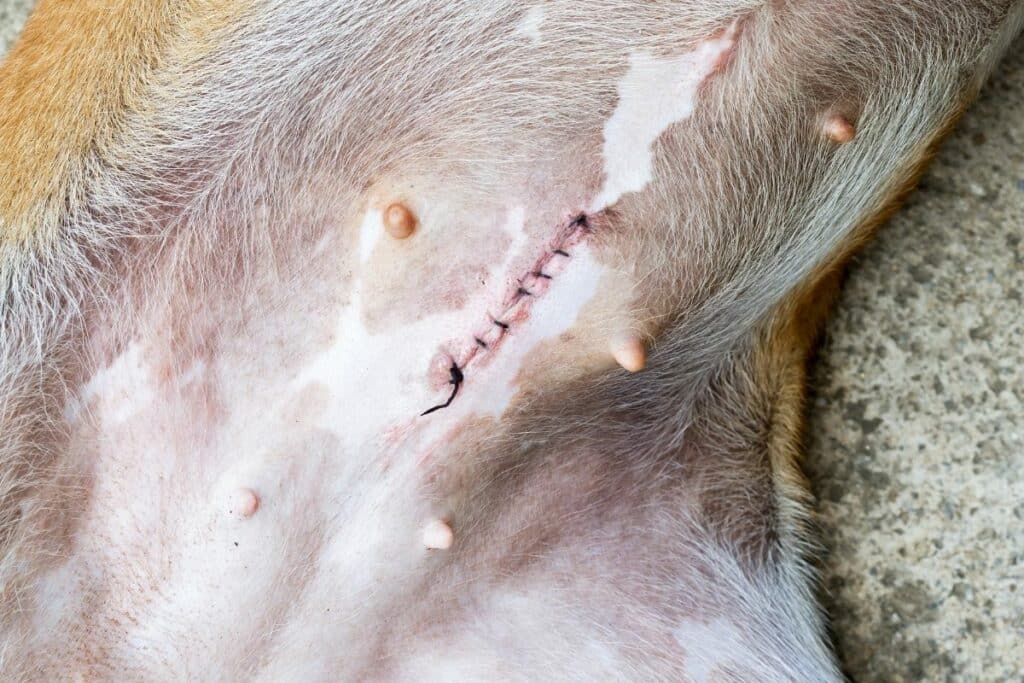In order to prevent your female dog from having unwanted litters of puppies or contracting cervical cancer, ensuring that you take them for the spaying procedure is just part of being responsible pet owners.
This is an excellent way to ensure that your furry friend has the best quality of life without having to worry about them going into heat all the time and trying to disappear for days on end.

But after the whole procedure has finished, your pet will need a recuperation period so that the healing process can begin.
While your dog’s skin and muscles are trying to heal themselves, you may notice the odd lumps or bumps around the area where they were spayed.
There will of course be naturally occurring inflammation during this time, but if the swelling or lumps look an angry red, there is pus around the site, or any kind of discharge, it will be worth taking your dog to the vet to ensure that everything’s okay.
Today, we’re going to cover everything you need to know about the possible cause of a lump where your dog has been spayed. And remember, if you are ever in doubt, then you should take your pet to the vet so that they can be examined further.
Is It Normal for a Dog to Have a Bulge after Being Spayed?
After your dog has had abdominal surgery such as spaying, you will of course want them to make a successful recovery.
So you will of course be anxiously checking the site of the incision to ensure that it is able to heal properly. If there is a slight lump under the incision site, this is simply the internal stitches, and isn’t anything to worry about.
So if you notice this lump is still there a couple of days after surgery, then it’s nothing to worry about.
Make sure that you get your dog to wear a plastic collar after surgery to prevent them from licking at their stitches. This will ensure that the healing process is able to continue as normal without any irritation from your dog’s tongue or saliva.
However, if you notice a large lump around the site of the spaying several days post surgery, this could be indicative of a seroma being in place.
This is basically where fluid has collected under the site of the incision. Generally it isn’t anything to worry about, and it will start to go away on its own.
However, if this hasn’t had a chance to heal after surgery and is still present many days later, you will need to take your dog to the vet just in case they need any medication to reduce the seroma.
Other types of bump that can occur is where the skin sort of folds in on itself. This is nothing to be worried about, as the site of the incision is starting to heal and pull the skin tighter.
This can create a bit of extra tissue, which is simply folded over on itself. There’s no need to worry about this hurting your dog at all. These folds of tissue are nothing to be concerned about.
Another thing to bear in mind is that different parts of the average incision will take different times to heal. The middle part of a healing incision is likely to heal quicker than the top or the bottom.
So if you notice a small red lump at the top of the incision site, then this is just a normal part of the healing process. Make sure to keep an eye on this so that if the redness gets worse, you can take your dog to the vet for some medical attention.
Is Some Swelling Normally After a Spay?
After major surgery such as a spay, it is of course normal for some swelling to be in place. This will of course start to go down over time as the dissolvable sutures start to naturally dissolve.
If you notice the incision site starts to look red and angry over time, with pus or any kind of discharge oozing out, this could be an indicator of a suture reaction. This will involve taking your pet to the vet again so that they can give you suitable medication for the suture reaction.
Some pinkness to the skin is perfectly normal after such serious surgery. However, this should start to go away after a couple of days once the wound starts to heal properly. In general, any kind of swelling around the site of the spay site should go away within 5 to 7 days.
If you notice that the swelling is still in place after this time, you will need to take your pet to the vet so that they can give your dog the care and attention they need to heal properly.
Another thing to bear in mind is whether your pet’s behavior has changed at all during this time. If they become anxious, unsettled, or are clearly very distressed, this couldn’t indicate that they are in pain and something isn’t quite right with the healing process.
So the general rule of thumb should be that if the swelling or redness is in place after a week, you will need to take your pet back to the vet for further medical attention.
How Long Does it Take for Swelling to Go Down After Spaying?
As we’ve discussed in more detail above, it is perfectly normal for there to be some swelling in place after your dog has been spayed. Spay surgery is of course major abdominal surgery, so it’s only natural that there will be some swelling as the muscle tissue tries to knit itself back together during the healing process.
But you may be wondering how long it will take for the swelling to go down, and whether this is a normal part of the process.
It will take anywhere between 5 and 7 days for the swelling to start to go down. If you notice after this time that the swelling hasn’t gone down at all and that the skin is still quite an angry red, or that there is pus or other types of discharge being emitted from the wound.
It will be worth taking your pet to the vets just to make sure that everything is okay.
This could be indicative of other issues which your vet will need to deal with. It will be best to stage an early intervention so that things don’t get the chance to spiral and become worse.
Early intervention is better than leaving your dog with excessive swelling for several weeks before you take them to the vet. If your dog’s behavior has also altered in this time, it could be a sign of other issues at play.
How To Deal with a Seroma After Spay Surgery?
The vast majority of small seromas won’t be anything for you to worry about after your dog’s spay surgery. These should start to go down themselves after a while, so they won’t require a trip to the vet’s surgery.
However, large seromas can pose a problem. If they haven’t started to go down after a couple of days, you will need to take them to the vet. This is because the seroma likely needs to be drained so that this excess fluid can’t hamper the healing process.
If a seroma was left to its own devices, these can calcify over time, forming a hard lump under your dog’s skin.
So to prevent this happening, your vet will need to drain the seroma, often using a long needle. It will be best to take your pet to the veterinary surgery so that they can sort this for you.
They will know how to do this safely and without causing your pet too much pain. They can also see whether your dog needs further treatment such as antibiotics to fight any lingering infection.
In Summary
So there you have it! You now know that the vast majority of lumps and bumps that can appear after your dog’s spay surgery are just a normal part of the healing process. These are just signs of your dog’s body healing, and are nothing to worry about.
If you notice these lumps and bumps immediately after the surgical procedure, this is likely just the suture material which is yet to dissolve.
If the lump appears to be filled with fluid, this is likely a seroma. This should go down on its own after a couple of days, but it’s still worth keeping an eye on.
If you notice that the seroma doesn’t decrease in size over time, it will be worth taking your dog to see your vet just to make sure that everything’s okay and that your pet doesn’t need antibiotics or other types of medication.
The general rule of thumb is that small lumps and bumps aren’t anything to worry about. But if in doubt, you should always contact your vet to see what their advice would be.
- What Dog Breeds Have Pink Skin? - March 24, 2023
- What Are the Most Inspiring Dog Breeding Quotes? - March 20, 2023
- Can Pheromone Spray Help Improve Dog Breeding Results? - March 19, 2023








